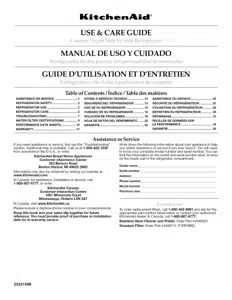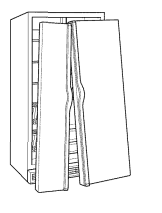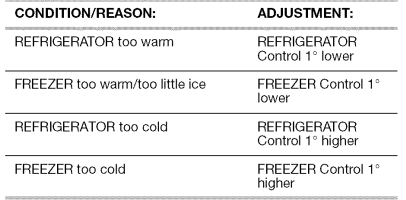Documents: Go to download!
User Manual
- Owner's manual - (English, French, Spanish)
- Installation Instruction - (English)

- IMPORTANT SAFETY INSTRUCTIONS
- Proper Disposal of Your Old Refrigerator
- USING THE CONTROLS
- Convertible Drawer Temperature Control
- Crisper Humidity Control
- Door Air Control
- REFRIGERATOR CARE
- TROUBLESHOOTING
- REFRIGERATOR OPERATION
- TEMPERATURE AND MOISTURE
- ICE AND WATER
Table of contents
User Manual KitchenAid KSCS25FTMS02 side-by-side refrigerator
IMPORTANT SAFETY INSTRUCTIONS
WARNING: To reduce the risk of fire, electric shock, or injury when using your refrigerator, follow these basic precautions:
- Plug into a grounded 3 prong outlet.
- Do not remove ground prong.
- Do not use an adapter.
- Do not use an extension cord.
- Disconnect power before servicing.
- Replace all parts and panels before operating.
- Remove doors from your old refrigerator.
- Use nonflammable cleaner.
- Keep flammable materials and vapors, such as gasoline, away from refrigerator.
- Use two or more people to move and install refrigerator.
- Disconnect power before installing ice maker (on ice maker kit ready models only).
- Use a sturdy glass when dispensing ice (on some models).
Proper Disposal of Your Old Refrigerator
IMPORTANT: Child entrapment and suffocation are not problems of the past. Junked or abandoned refrigerators are still dangerous - even if they will sit for "just a few days." If you are getting rid of your old refrigerator, please follow these instructions to help prevent accidents.
Before You Throw Away Your Old Refrigerator or Freezer:
- Take off the doors.
- Leave the shelves in place so that children may not easily climb inside.

USING THE CONTROLS
NOTE: Make sure the refrigerator is plugged into a grounded 3 prong outlet.
For your convenience, your refrigerator controls are preset at the factory. When you first install your refrigerator, make sure that the controls are still preset to the mid-settings as shown.

IMPORTANT:
- The refrigerator control adjusts the refrigerator compartment temperature. The freezer control adjusts the freezer compartment temperature.
- The displays normally show the actual temperatures inside the refrigerator and freezer compartments. Sometimes, temperatures may vary slightly in different areas of each compartment. For example, frequently opening the door allows air from the room to enter the compartment, exposing door bins to room-temperature air. When reading the display, keep in mind that it shows an average temperature for the entire compartment. If you want to view the temperature you set for the compartment rather than the actual temperature, see "Viewing Set Points."
- Wait 24 hours before you put food into the refrigerator. If you add food before the refrigerator has cooled completely, your food may spoil.
NOTE: Adjusting the refrigerator and freezer controls to a lower (colder) setting will not cool the compartments any faster.
Turning Refrigerator On
- If the refrigerator is off, press COOLING ON/OFF to turn the cooling on.
- To turn your refrigerator off, press COOLING ON/OFR Your refrigerator will not cool when the control is set to Off.
NOTE: Pressing the Cooling On/Off button does not disconnect power to the refrigerator. The interior lights will turn off if either compartment door is open for more than 10 minutes. Simply close and open the door to turn on the interior lights.
Viewing Set Points
The factory recommended set points are 0°F (-18°C) for the freezer and 37°F (3°C) for the refrigerator.
Set point range for the freezer: -6 ° to 6°F (-21 °C to -14°C)
Set point range for the refrigerator: 32° to 46°F (0°C to 8°C)
To view the set point temperatures, press either the up or down button for the refrigerator or freezer temperature. The display will become brighter to indicate that you are viewing the set points. Five seconds after an adjustment is made, the display lights will dim and return to the actual temperature.
NOTE: During automatic defrost cycles, the actual temperature displayed may be higher than the set point. This is normal. The actual temperatures should return to the set points within a few hours following completion of the defrost cycle.
Adjusting Controls
The mid-settings indicated in the previous section should be correct for normal household refrigerator usage. The controls are set correctly when milk or juice is as cold as you like and when ice cream is firm
If the temperature is too warm or too cold in the refrigerator or freezer, first check the air vents to be sure they are not blocked. If you need to adjust temperatures, use the settings listed in the chart below as a guide. Wait at least 24 hours between adjustments.

Additional Control Panel Features
Temp Mode
- Press the °C button to select either Celsius or Fahrenheit temperature displays.
Max Cool
Use Max Cool to speed cooling when large grocery loads are added. Max Cool sets the refrigerator temperature to 34°F (1°C) and the freezer temperature to -6°F (-21 °C) for 24 hours.
NOTE: While Max Cool is on, the display shows the Max Cool temperature set points. After 24 hours or when Max Cool is manually turned off, the set points will be returned to their previous setting.
- Press MAX COOL to select this mode. Max Cool will stay on for 24 hours or until it is manually turned off.
Convertible Drawer Temperature Control
The control can be adjusted to properly chill meats or vegetables. The air inside the pan is cooled to avoid "spot" freezing and can be set to keep meats at the National Livestock and Meat Board recommended storage temperatures of 28° to 32°F (-2 ° to 0°C). The convertible drawer temperature control is preset to the PRODUCE setting.
To Store Meat:
Set the control to one of the three MEAT settings to store meat at its optimal storage temperature.
To Store Vegetables:
Set the control to PRODUCE to store vegetables at their optimal storage temperatures.
NOTE: If food starts to freeze, move the control to the left (less cold). Remember to wait 24 hours between adjustments.
Crisper Humidity Control
You can control the amount of humidity in the moisture-sealed crisper. Adjust the control to any setting between LOW and HIGH.
LOW (open) for best storage of fruits and vegetables with skins.
HIGH (closed) for best storage of fresh, leafy vegetables.
Door Air Control
The door air control is located on the left-hand side of the refrigerator compartment.

- Slide the door air control to the left to reduce the flow of cold air to the bin or can rack and make it less cold.
- Slide the door air control to the right to increase the flow of cold air to the bin or can rack and make it colder.
REFRIGERATOR CARE
CLEANING
Both the refrigerator and freezer sections defrost automatically. However, clean both sections about once a month to avoid buildup of odors. Wipe up spills immediately.
IMPORTANT: Because air circulates between both sections, any odors formed in one section will transfer to the other. You must thoroughly clean both sections to eliminate odors. To avoid odor transfer and drying out of food, wrap or cover foods tightly.
To Clean Your Refrigerator:
NOTE: Do not use abrasive or harsh cleaners such as window sprays, scouring cleansers, flammable fluids, cleaning waxes, concentrated detergents, bleaches or cleansers containing petroleum products on plastic parts, interior and door liners or gaskets. Do not use paper towels, scouring pads, or other harsh cleaning tools.
- Unplug refrigerator or disconnect power.
- Hand wash, rinse, and dry removable parts and interior surfaces thoroughly. Use a clean sponge or soft cloth and a mild detergent in warm water.
- Wash stainless steel and painted metal exteriors with a clean sponge or soft cloth and a mild detergent in warm water.
- There is no need for routine condenser cleaning in normal home operating environments. If the environment is particularly greasy or dusty, or there is significant pet traffic in the home, the condenser should be cleaned every 2 to 3 months to ensure maximum efficiency. If you need to clean the condenser: Removethe base grille. / Use a vacuum cleaner with a soft brush to clean the grille, the open areas behind the grille and the front surface area of the condenser. / Replace the base grille when finished.
- Plug in refrigerator or reconnect power
CHANGING THE LIGHT BULBS
NOTE: Not all bulbs will fit your refrigerator. Be sure to replace the bulb with one of the same size, shape and wattage. On some models, the dispenser light requires a heavy duty 10-watt bulb. All other lights require a 40-watt bulb. Replacement bulbs are available from your dealer.
- Unplug refrigerator or disconnect power.
- Remove light shield when applicable. NOTE: To clean the light shield, wash it with warm water and liquid detergent. Rinse and dry the shield well.
- Remove light bulb and replace with one of the same size, shape and wattage.
- Replace light shield when applicable.
- Plug in refrigerator or reconnect power.
TROUBLESHOOTING
REFRIGERATOR OPERATION
The refrigerator will not operate
-
Power cord unplugged? Plug into a grounded 3 prong outlet.
- Is outlet working? Plug in a lamp to see if the outlet is working.
- Household fuse blown or circuit breaker tripped? Replace the fuse or reset the circuit breaker. If the problem continues, call an electrician.
- Are controls on? Make sure the refrigerator controls are on. See "Using the Controls."
- New installation? Allow 24 hours following installation for the refrigerator to cool completely.
NOTE: Adjusting the temperature controls to coldest setting will not cool either compartment more quickly.
The motor seems to run too much
Your new refrigerator may run longer than your old one due to its high-efficiency compressor and fans. To maximize energy efficiency, the compressor changes speed to provide just the right amount of cooling as it is needed. Your refrigerator may run as much as 100% of the time, but it will still use less energy than an older refrigerator. You may notice that it runs more often when the room is warm, a large amount of food is added to either compartment, or the doors are opened often.
The refrigerator is noisy
Refrigerator noise has been reduced over the years. Due to this reduction, you may hear intermittent noises from your new refrigerator that you did not notice from your old model. Below are listed some normal sounds with an explanation.
- Buzzing - heard when the water valve opens to fill the ice maker
- Pulsating - fans/compressor adjusting to optimize performance
- Rattling - flow of refrigerant, water line, or from items placed on top of the refrigerator
- Sizzling/Gurgling - water dripping on the heater during defrost cycle
- Popping - contraction/expansion of inside walls, especially during initial cool-down
- Water running - may be heard when water melts during the defrost cycle and runs into the drain pan
- Creaking/Cracking - occurs as ice is being ejected from the ice maker mold.
The doors will not close completely
Check the following:
- Are food packages blocking the door open?
- Are all bins and shelves pushed back into the correct positions?
Are all bins and shelves pushed back into the correct positions?
- Are the gaskets dirty or sticky? Clean gaskets with mild soap and warm water
- Has the door been opened and closed within the last few seconds? Wait at least 30 seconds to reopen the doors.
TEMPERATURE AND MOISTURE
Temperature is too warm
- Are the air vents blocked in either compartment?
- Are the door(s) opened often?
- Has a large amount of food just been added to the refrigerator or freezer?
- Are the controls set correctly for the surrounding conditions?
There is interior moisture buildup
- Are the air vents blocked in the refrigerator?
- Are the door(s) opened often?
- Is the room humid?
- Are the controls set correctly for the surrounding conditions?
- Was an automatic self-defrost cycle completed?
Items in meat pan/crisper are freezing
The temperature inside the meat pan/crisper may become too cold, especially when using some additional control panel features. Adjust the meat pan control to the closed setting
ICE AND WATER
The ice maker is not producing ice or not enough ice
- Is the ice maker wire shutoff arm or switch (depending on models) in the OFF position?
- Is the water line shutoff valve to the refrigerator turned on?
- Has the ice maker just been installed? Is the freezer temperature cold enough to produce ice? Wait 24 hours after ice maker hookup for ice production to begin. Allow 3 days after ice production begins to completely fill ice container.
- Does the ice maker mold have water in it or has no ice been produced? Make sure your refrigerator has been connected to a water supply and the supply shutoff valve is turned on.
- Has a large amount of ice just been removed? Allow 24 hours for ice maker to produce more ice.
- Is there a water filter installed on the refrigerator? The filter may be clogged or installed incorrectly.
- Is an ice cube jammed in the ice maker ejector arm? For models with an interior ice bin, remove the ice from the ejector arm with a plastic utensil.
- Is a reverse osmosis water filtration system connected to your cold water supply? See "Water Supply Requirements" in either the Installation Instruction booklet or the Use & Care Guide.
The ice cubes are hollow or small
- Is the water shutoff valve fully open?
- Are there kinks in the water lines that could restrict water flow?
- If you are using a water filter, remove the filter and operate the dispenser. If water flow increases, the filter is clogged or incorrectly installed.
- Is a reverse osmosis water filtration system connected to your cold water supply? See "Water Supply Requirements" in either the Installation Instructions or the Use & Care Guide.
- If you still have questions regarding your water pressure, call a licensed, qualified plumber.
Off-taste, odor or gray color in the ice
- Are the plumbing connections new, causing discolored or offflavored ice?
- Have the ice cubes been stored too long?
- Does the freezer and ice bin need to be cleaned?
- Has food in the freezer or refrigerator been wrapped properly?
- Does the water contain minerals (such as sulfur)? A filter may need to be installed to remove the minerals.
- Is there a water filter installed on the refrigerator? Gray or dark discoloration in ice indicates that the water filtration system needs additional flushing.
The ice dispenser will not operate properly
If the ice storage bin is located on the door, remove the temporary shield from underneath the ice storage bin. See "Ice Maker and Storage Bin."'
Check the following:
- Is the freezer door closed completely?
- Is the ice bin installed correctly?
- Is there ice in the bin?
- Has the ice frozen in the ice bin?
- Is ice stuck in the delivery chute?
- Has the wrong ice been added to the bin? Use only cubes produced by the current ice maker.
- Has the ice melted around the auger (metal spiral) in the ice bin? Empty the ice container. Use warm water to melt the ice if necessary.
- Is the ice dispenser stalling while dispensing "crushed" ice? Change the ice button from "crushed" to "cubed." If cubed ice dispenses correctly, depress the button for "crushed" ice and begin dispensing again.
- Has the dispenser lever been held in too long? Ice will stop dispensing when the arm is held in too long. Wait 3 minutes for dispenser motor to reset before using again.
The water dispenser will not operate properly
- Is the freezer door closed completely?
- Is the water shutoff valve not turned on, incorrectly installed or clogged?
- Is the water line connected at the source?
- Is there a kink in the home water source line?
- Has the water system not filled? The water system needs to be filled the first time it is used.
- Is the refrigerator connected to a cold water line with water pressure of at least 30 psi (207 kPa)? The water pressure to the home determines the flow from the dispenser
- Is there a water filter installed on the refrigerator? The filter may be clogged or incorrectly installed.
- Is there a water filter installed on the refrigerator? The filter may be clogged or incorrectly installed.
Water is leaking from the dispenser
- Is the glass not being held under the dispenser long enough?
- Has the water system been flushed since installation or changing filters?
The dispenser water is not cool enough
- Has the refrigerator been newly installed or a large amount of water recently dispensed? Allow 24 hours for the refrigerator to cool completely.
- Has water not been recently dispensed? The first glass of water may not be cool. Discard the first glass of water.
See other models: KUDS30IVWH0 KECD865HBT0 KUDS30IXBT9 KFCS22EVMS7 KBLS22KWMS4
